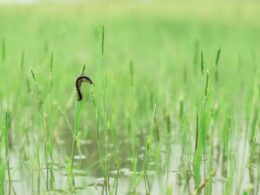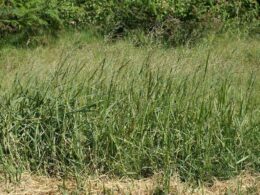Microstegium Vimineum
Stilt grass (Microstegium Vimineum) is an annual grass. It’s a native species to Asia. It has been introduced to North America and Europe, where it is considered an invasive plant. The plant is also known by the names Japanese stiltgrass, packing grass, and Nepalese browntop. Stilt grass spreads rapidly through both seed dispersal and vegetative reproduction.
This plant species commonly invades disturbed areas such as roadsides, trails, and vacant lots. Once established, it can quickly spread into natural areas and displace native vegetation. Stilt grass is resistant to herbicides and difficult to control once it becomes established. Prevention is the best method of controlling this invasive species.
Characteristics of Stilt Grass
Stilt grass gets its name from how it grows – the blades of grass are long and thin, and they grow on stiff stems that are slightly elevated above the ground. Stilt grass grows in dense mats and can reach up to 3 feet in height. The leaves are slender, lance-shaped, and have a distinctive silvery stripe across the midrib. Stilt grass produces small, pale green flowers that are arranged in flower spikes in the summer. It has a shallow root system, which makes it easy to hand pull if it’s in small parts.
Stiltgrass Seed Germination
This invasive plant species reproduces mainly by seed, and each plant can produce 100 (some even 1,000) seeds per season. Seeds can remain viable in the soil for up to 5 years, and they typically germinate in late spring or early summer. However, stiltgrass can also germinate in fall or winter if conditions are favorable.
Stilt Grass as an Invasive Species
Japanese stiltgrass is an annual grass that is resistant to herbicides and will return, unless properly taken care of. The seeds are easily dispersed by wind and water, and they can remain viable in the soil for several years. The aggressive growth habit makes stilt grass a nuisance in gardens, fields, and natural areas. In addition, stilt grass provides little food or shelter value for wildlife.
Stilt grass is also a problem for both homeowners and farmers, as it can reduce crop yields and make gardens look untidy. If you have stiltgrass on your property, the best course of action is to remove it manually before it has a chance to spread further. Mowing is recommended in late summer.
In response to the threat posed by stilt grass, the European Commission has included the species on the European list of invasive alien species. This list is designed to help Member States take action to prevent the introduction and spread of harmful species. Stilt grass is currently most prevalent in the Balkans, but it is also found in other parts of Europe.
Stilt Grass as Packing Material
Surprisingly, this grass has one redeeming quality: it is excellent to use as a packing material. Japanese Stiltgrass is very light and compressible, making it ideal for protecting delicate items during shipping. Additionally, the grass is hydrophilic, meaning that it absorbs water well. This helps to keep items dry during transit. As a result, Japanese Stiltgrass is an unexpected but effective packing material for a variety of items, including precious ones, like porcelain. It is said that this invasive grass had found itself in the USA in 1919 by accident in the form of packing material.
Controlling Japanese Stiltgrass
Japanese stiltgrass is particularly troublesome in woodlands and wetlands, where it can quickly take over understory vegetation. Many states have implemented programs to control stiltgrass populations, but the most effective method of control is still prevention. This means preventing the introduction of stiltgrass to new areas, and quickly removing any plants that are found before they have a chance to spread.
It could be controlled with the use of a pre-emergent herbicide, which is usually aimed at crabgrass. However, it does not always prevent the seeds from germinating, and may come back. Glyphosate might be used as well, but it may damage other plants.
Biological Control
Biological control is the use of natural predators to control the population of a damaging pest. This is often done in agricultural settings, in order to protect crops from voracious insects. In recent years, biological control has also been used as a way to combat the spread of invasive species, such as stilt grass.
One method of controlling stilt grass populations is to release natural predators into the environment. Ladybugs, for example, are known to eat stilt grass seeds, which can help to prevent the plant from spreading. Similarly, wasps have been shown to destroy stilt grass plants, reducing their numbers in an area. Biological control is often seen as a more environmentally-friendly way to combat pests. Additionally, it can be more effective than other methods, such as manual removal, at controlling large infestations.
Fot. ilustracyjne: James H. Miller via wikipedia, CC BY-SA 3.0



















